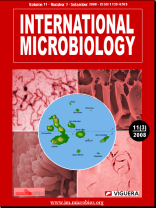Production of two novel laccase isoforms by a thermotolerant strain of Pycnoporus sanguineus isolated from an oil-polluted tropical habitat
Keywords:
Pycnoporus sanguineus, Bjerkandera adusta, Basidiomycota, laccases, thermotolerant fungi, bioremediationAbstract
A thermotolerant and halotolerant strain of Pycnoporus sanguineus was isolated from an oil-polluted site in a tropical area located in Veracruz, Mexico. This strain was able to grow at 47ºC and in culture medium containing 500 mM NaCl. The strain was also tolerant to the presence of 30,000 ppm of crude Maya oil. A 68-kDa protein purified submerged cultures exhibited laccase activity towards 2,2′-azino-bis(3-ethylbenzthiazoline-6-sulfonic acid) (ABTS), guaiacol, syringaldazine and o-dianisidine, for which it presented the highest affinity (Km = 43 µM). Two-dimensional gel electrophoresis analysis showed that, unusual for laccases, the enzyme has two active isoforms, with isoelectric points of 7.00 and 7.08. The purified enzyme showed high thermostability, retaining 40% of its original activity after 3 h at 60ºC. This property seems to correlate with a long “shelf-life”, given that at 40ºC enzyme activity was only gradually lost over a 5-day period incubation. Both, the fungus and its laccase aer likely to have high potential for biotechnological applications.Downloads
Published
2008-12-11
Issue
Section
Research Articles
License
Submission of a manuscript to International Microbiology implies: that the work described has not been published before, including publication in the World Wide Web (except in the form of an Abstract or as part of a published lecture, review, or thesis); that it is not under consideration for publication elsewhere; that all the coauthors have agreed to its publication. The corresponding author signs for and accepts responsability for releasing this material and will act on behalf of any and all coauthors regarding the editorial review and publication process.If an article is accepted for publication in International Microbiology, the authors (or other copyright holder) must transfer to the journal the right–not exclusive–to reproduce and distribute the article including reprints, translations, photographic reproductions, microform, electronic form (offline, online) or any other reproductions of similar nature. Nevertheless, all article in International Microbiology will be available on the Internet to any reader at no cost. The journal allows users to freely download, copy, print, distribute, search, and link to the full text of any article, provided the authorship and source of the published article is cited. The copyright owner's consent does not include copying for new works, or resale. In these cases, the specific written permission of International Microbiology must first be obtained.
Authors are requested to create a link to the published article on the journal's website. The link must be accompanied by the following text: "The original publication is available on LINK at <http://www.im.microbios.org>. Please use the appropiate URL for the article in LINK. Articles disseminated via LINK are indexed, abstracted, and referenced by many abstracting and information services, bibliographic networks, subscription agencies, library networks, and consortia.




